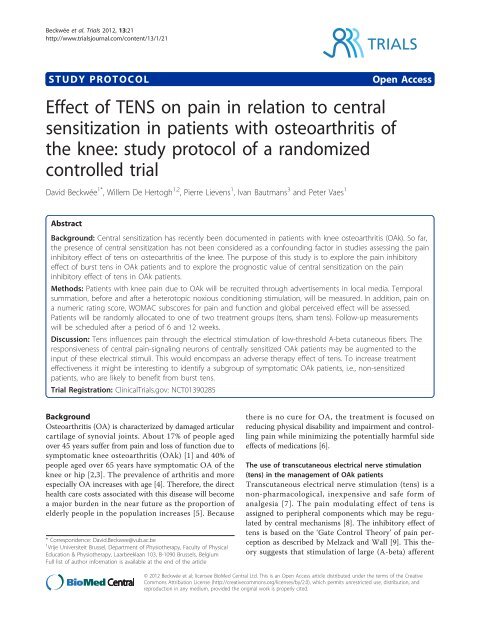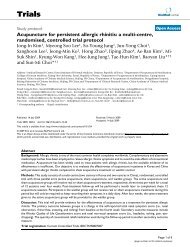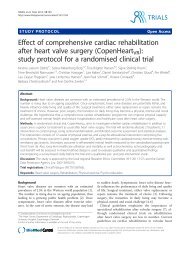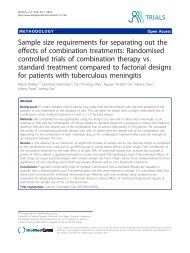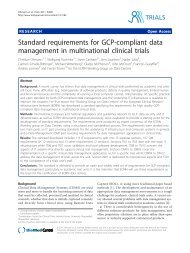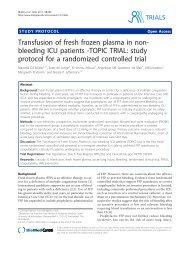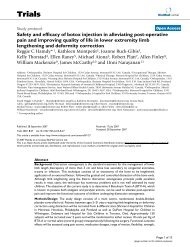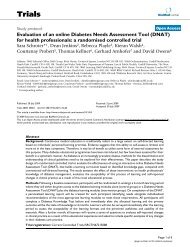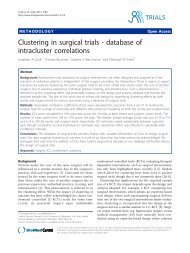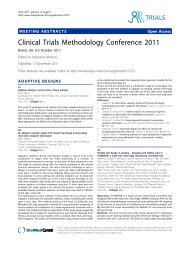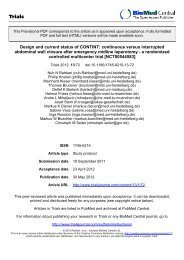Effect of TENS on pain in relation to central ... - BioMed Central
Effect of TENS on pain in relation to central ... - BioMed Central
Effect of TENS on pain in relation to central ... - BioMed Central
Create successful ePaper yourself
Turn your PDF publications into a flip-book with our unique Google optimized e-Paper software.
Beckwée et al. Trials 2012, 13:21<br />
http://www.trialsjournal.com/c<strong>on</strong>tent/13/1/21<br />
TRIALS<br />
STUDY PROTOCOL<br />
Open Access<br />
<str<strong>on</strong>g>Effect</str<strong>on</strong>g> <str<strong>on</strong>g>of</str<strong>on</strong>g> <str<strong>on</strong>g>TENS</str<strong>on</strong>g> <strong>on</strong> <strong>pa<strong>in</strong></strong> <strong>in</strong> relati<strong>on</strong> <strong>to</strong> <strong>central</strong><br />
sensitizati<strong>on</strong> <strong>in</strong> patients with osteoarthritis <str<strong>on</strong>g>of</str<strong>on</strong>g><br />
the knee: study pro<strong>to</strong>col <str<strong>on</strong>g>of</str<strong>on</strong>g> a randomized<br />
c<strong>on</strong>trolled trial<br />
David Beckwée 1* , Willem De Her<strong>to</strong>gh 1,2 , Pierre Lievens 1 , Ivan Bautmans 3 and Peter Vaes 1<br />
Abstract<br />
Background: <strong>Central</strong> sensitizati<strong>on</strong> has recently been documented <strong>in</strong> patients with knee osteoarthritis (OAk). So far,<br />
the presence <str<strong>on</strong>g>of</str<strong>on</strong>g> <strong>central</strong> sensitizati<strong>on</strong> has not been c<strong>on</strong>sidered as a c<strong>on</strong>found<strong>in</strong>g fac<strong>to</strong>r <strong>in</strong> studies assess<strong>in</strong>g the <strong>pa<strong>in</strong></strong><br />
<strong>in</strong>hibi<strong>to</strong>ry effect <str<strong>on</strong>g>of</str<strong>on</strong>g> tens <strong>on</strong> osteoarthritis <str<strong>on</strong>g>of</str<strong>on</strong>g> the knee. The purpose <str<strong>on</strong>g>of</str<strong>on</strong>g> this study is <strong>to</strong> explore the <strong>pa<strong>in</strong></strong> <strong>in</strong>hibi<strong>to</strong>ry<br />
effect <str<strong>on</strong>g>of</str<strong>on</strong>g> burst tens <strong>in</strong> OAk patients and <strong>to</strong> explore the prognostic value <str<strong>on</strong>g>of</str<strong>on</strong>g> <strong>central</strong> sensitizati<strong>on</strong> <strong>on</strong> the <strong>pa<strong>in</strong></strong><br />
<strong>in</strong>hibi<strong>to</strong>ry effect <str<strong>on</strong>g>of</str<strong>on</strong>g> tens <strong>in</strong> OAk patients.<br />
Methods: Patients with knee <strong>pa<strong>in</strong></strong> due <strong>to</strong> OAk will be recruited through advertisements <strong>in</strong> local media. Temporal<br />
summati<strong>on</strong>, before and after a hetero<strong>to</strong>pic noxious c<strong>on</strong>diti<strong>on</strong><strong>in</strong>g stimulati<strong>on</strong>, will be measured. In additi<strong>on</strong>, <strong>pa<strong>in</strong></strong> <strong>on</strong><br />
a numeric rat<strong>in</strong>g score, WOMAC subscores for <strong>pa<strong>in</strong></strong> and functi<strong>on</strong> and global perceived effect will be assessed.<br />
Patients will be randomly allocated <strong>to</strong> <strong>on</strong>e <str<strong>on</strong>g>of</str<strong>on</strong>g> two treatment groups (tens, sham tens). Follow-up measurements<br />
will be scheduled after a period <str<strong>on</strong>g>of</str<strong>on</strong>g> 6 and 12 weeks.<br />
Discussi<strong>on</strong>: Tens <strong>in</strong>fluences <strong>pa<strong>in</strong></strong> through the electrical stimulati<strong>on</strong> <str<strong>on</strong>g>of</str<strong>on</strong>g> low-threshold A-beta cutaneous fibers. The<br />
resp<strong>on</strong>siveness <str<strong>on</strong>g>of</str<strong>on</strong>g> <strong>central</strong> <strong>pa<strong>in</strong></strong>-signal<strong>in</strong>g neur<strong>on</strong>s <str<strong>on</strong>g>of</str<strong>on</strong>g> <strong>central</strong>ly sensitized OAk patients may be augmented <strong>to</strong> the<br />
<strong>in</strong>put <str<strong>on</strong>g>of</str<strong>on</strong>g> these electrical stimuli. This would encompass an adverse therapy effect <str<strong>on</strong>g>of</str<strong>on</strong>g> tens. To <strong>in</strong>crease treatment<br />
effectiveness it might be <strong>in</strong>terest<strong>in</strong>g <strong>to</strong> identify a subgroup <str<strong>on</strong>g>of</str<strong>on</strong>g> symp<strong>to</strong>matic OAk patients, i.e., n<strong>on</strong>-sensitized<br />
patients, who are likely <strong>to</strong> benefit from burst tens.<br />
Trial Registrati<strong>on</strong>: Cl<strong>in</strong>icalTrials.gov: NCT01390285<br />
Background<br />
Osteoarthritis (OA) is characterized by damaged articular<br />
cartilage <str<strong>on</strong>g>of</str<strong>on</strong>g> synovial jo<strong>in</strong>ts. About 17% <str<strong>on</strong>g>of</str<strong>on</strong>g> people aged<br />
over 45 years suffer from <strong>pa<strong>in</strong></strong> and loss <str<strong>on</strong>g>of</str<strong>on</strong>g> functi<strong>on</strong> due <strong>to</strong><br />
symp<strong>to</strong>matic knee osteoarthritis (OAk) [1] and 40% <str<strong>on</strong>g>of</str<strong>on</strong>g><br />
people aged over 65 years have symp<strong>to</strong>matic OA <str<strong>on</strong>g>of</str<strong>on</strong>g> the<br />
knee or hip [2,3]. The prevalence <str<strong>on</strong>g>of</str<strong>on</strong>g> arthritis and more<br />
especially OA <strong>in</strong>creases with age [4]. Therefore, the direct<br />
health care costs associated with this disease will become<br />
a major burden <strong>in</strong> the near future as the proporti<strong>on</strong> <str<strong>on</strong>g>of</str<strong>on</strong>g><br />
elderly people <strong>in</strong> the populati<strong>on</strong> <strong>in</strong>creases [5]. Because<br />
* Corresp<strong>on</strong>dence: David.Beckwee@vub.ac.be<br />
1 Vrije Universiteit Brussel, Department <str<strong>on</strong>g>of</str<strong>on</strong>g> Physiotherapy, Faculty <str<strong>on</strong>g>of</str<strong>on</strong>g> Physical<br />
Educati<strong>on</strong> & Physiotherapy, Laarbeeklaan 103, B-1090 Brussels, Belgium<br />
Full list <str<strong>on</strong>g>of</str<strong>on</strong>g> author <strong>in</strong>formati<strong>on</strong> is available at the end <str<strong>on</strong>g>of</str<strong>on</strong>g> the article<br />
there is no cure for OA, the treatment is focused <strong>on</strong><br />
reduc<strong>in</strong>g physical disability and impairment and c<strong>on</strong>troll<strong>in</strong>g<br />
<strong>pa<strong>in</strong></strong> while m<strong>in</strong>imiz<strong>in</strong>g the potentially harmful side<br />
effects <str<strong>on</strong>g>of</str<strong>on</strong>g> medicati<strong>on</strong>s [6].<br />
The use <str<strong>on</strong>g>of</str<strong>on</strong>g> transcutaneous electrical nerve stimulati<strong>on</strong><br />
(tens) <strong>in</strong> the management <str<strong>on</strong>g>of</str<strong>on</strong>g> OAk patients<br />
Transcutaneous electrical nerve stimulati<strong>on</strong> (tens) is a<br />
n<strong>on</strong>-pharmacological, <strong>in</strong>expensive and safe form <str<strong>on</strong>g>of</str<strong>on</strong>g><br />
analgesia [7]. The <strong>pa<strong>in</strong></strong> modulat<strong>in</strong>g effect <str<strong>on</strong>g>of</str<strong>on</strong>g> tens is<br />
assigned <strong>to</strong> peripheral comp<strong>on</strong>ents which may be regulated<br />
by <strong>central</strong> mechanisms [8]. The <strong>in</strong>hibi<strong>to</strong>ry effect <str<strong>on</strong>g>of</str<strong>on</strong>g><br />
tens is based <strong>on</strong> the ‘Gate C<strong>on</strong>trol Theory’ <str<strong>on</strong>g>of</str<strong>on</strong>g> <strong>pa<strong>in</strong></strong> percepti<strong>on</strong><br />
as described by Melzack and Wall [9]. This theory<br />
suggests that stimulati<strong>on</strong> <str<strong>on</strong>g>of</str<strong>on</strong>g> large (A-beta) afferent<br />
© 2012 Beckwée et al; licensee <strong>BioMed</strong> <strong>Central</strong> Ltd. This is an Open Access article distributed under the terms <str<strong>on</strong>g>of</str<strong>on</strong>g> the Creative<br />
Comm<strong>on</strong>s Attributi<strong>on</strong> License (http://creativecomm<strong>on</strong>s.org/licenses/by/2.0), which permits unrestricted use, distributi<strong>on</strong>, and<br />
reproducti<strong>on</strong> <strong>in</strong> any medium, provided the orig<strong>in</strong>al work is properly cited.
Beckwée et al. Trials 2012, 13:21<br />
http://www.trialsjournal.com/c<strong>on</strong>tent/13/1/21<br />
Page 2 <str<strong>on</strong>g>of</str<strong>on</strong>g> 7<br />
cutaneous fibers activate the <strong>in</strong>hibi<strong>to</strong>ry-<strong>in</strong>terneur<strong>on</strong>s <strong>in</strong><br />
the dorsal horn <str<strong>on</strong>g>of</str<strong>on</strong>g> de medulla. This may weaken the<br />
transmissi<strong>on</strong> <str<strong>on</strong>g>of</str<strong>on</strong>g> nociceptive signals from small diameter<br />
A-delta and C-fibers. As OA is a dynamic process that<br />
<strong>in</strong>volves phases <str<strong>on</strong>g>of</str<strong>on</strong>g> <strong>in</strong>flammati<strong>on</strong> with possible <strong>in</strong>crease<br />
<str<strong>on</strong>g>of</str<strong>on</strong>g> <strong>pa<strong>in</strong></strong> dur<strong>in</strong>g these phases, tens may then be <strong>in</strong>dicated<br />
as a facilita<strong>to</strong>r for exercise. The use <str<strong>on</strong>g>of</str<strong>on</strong>g> tens <strong>to</strong> relieve<br />
knee <strong>pa<strong>in</strong></strong> <strong>in</strong> osteoarthritis <str<strong>on</strong>g>of</str<strong>on</strong>g> the knee (OAk) is recommended<br />
<strong>in</strong> various cl<strong>in</strong>ical guidel<strong>in</strong>es as a c<strong>on</strong>servative<br />
treatment <strong>to</strong> relieve knee <strong>pa<strong>in</strong></strong> [10-12]. However, Rutjes<br />
et al. [13] c<strong>on</strong>clude <strong>in</strong> their meta-analysis that adequate<br />
evidence <strong>to</strong> support the use <str<strong>on</strong>g>of</str<strong>on</strong>g> any type <str<strong>on</strong>g>of</str<strong>on</strong>g> transcutaneous<br />
electrostimulati<strong>on</strong> <strong>in</strong> patients with knee osteoarthritis<br />
is lack<strong>in</strong>g.<br />
<strong>Central</strong> sensitizati<strong>on</strong> <strong>in</strong> patients with osteoarthritis <str<strong>on</strong>g>of</str<strong>on</strong>g> the<br />
knee<br />
<strong>Central</strong> sensitizati<strong>on</strong> is def<strong>in</strong>ed as “an augmentati<strong>on</strong> <str<strong>on</strong>g>of</str<strong>on</strong>g><br />
resp<strong>on</strong>siveness <str<strong>on</strong>g>of</str<strong>on</strong>g> <strong>central</strong> <strong>pa<strong>in</strong></strong>-signal<strong>in</strong>g neur<strong>on</strong>s <strong>to</strong> <strong>in</strong>put<br />
from low-threshold mechanorecep<strong>to</strong>rs” [14]. <strong>Central</strong> sensitizati<strong>on</strong><br />
embodies modified sensory process<strong>in</strong>g <strong>in</strong> the<br />
bra<strong>in</strong> and malfuncti<strong>on</strong><strong>in</strong>g <str<strong>on</strong>g>of</str<strong>on</strong>g> descend<strong>in</strong>g <strong>pa<strong>in</strong></strong>-<strong>in</strong>hibi<strong>to</strong>ry<br />
mechanisms [15]. The importance <str<strong>on</strong>g>of</str<strong>on</strong>g> <strong>central</strong> sensitizati<strong>on</strong><br />
as a potential underly<strong>in</strong>g mechanism <str<strong>on</strong>g>of</str<strong>on</strong>g> <strong>pa<strong>in</strong></strong> <strong>in</strong> OAk has<br />
recently ga<strong>in</strong>ed <strong>in</strong>terest [16]. In the past decade suggesti<strong>on</strong>s<br />
were already made c<strong>on</strong>cern<strong>in</strong>g the <strong>in</strong>fluence <str<strong>on</strong>g>of</str<strong>on</strong>g> sensitizati<strong>on</strong><br />
<str<strong>on</strong>g>of</str<strong>on</strong>g> wide dynamic range (WDR) dorsal horn<br />
neur<strong>on</strong>s when expla<strong>in</strong><strong>in</strong>g an <strong>in</strong>crease <str<strong>on</strong>g>of</str<strong>on</strong>g> the mechanical<br />
<strong>pa<strong>in</strong></strong> threshold after apply<strong>in</strong>g a blockage <str<strong>on</strong>g>of</str<strong>on</strong>g> A -beta nerve<br />
fibers [17]. C<strong>on</strong>t<strong>in</strong>uous and <strong>in</strong>tense nociceptive <strong>in</strong>put from<br />
the OA-damaged knee jo<strong>in</strong>t may encourage <strong>central</strong> sensitizati<strong>on</strong><br />
[18,19] and is assumed <strong>to</strong> play an important role<br />
<strong>in</strong> OA [20]. <strong>Central</strong> sensitizati<strong>on</strong> <strong>in</strong> patients with OAk was<br />
detected by Arendt-Nielsen and colleagues [16] by<br />
enhanced temporal summati<strong>on</strong> (TS) <str<strong>on</strong>g>of</str<strong>on</strong>g> <strong>pa<strong>in</strong></strong> and impaired<br />
diffuse noxious <strong>in</strong>hibi<strong>to</strong>ry c<strong>on</strong>trol (DNIC). TS is def<strong>in</strong>ed as<br />
an <strong>in</strong>crease <strong>in</strong> <strong>pa<strong>in</strong></strong> rat<strong>in</strong>g after repetitive stimulati<strong>on</strong> at a<br />
c<strong>on</strong>stant stimulus <strong>in</strong>tensity [21]. It is thought <strong>to</strong> be a psychophysiological<br />
correlate <str<strong>on</strong>g>of</str<strong>on</strong>g> w<strong>in</strong>d-up, which is def<strong>in</strong>ed as<br />
the <strong>in</strong>crease <strong>in</strong> resp<strong>on</strong>se magnitude <str<strong>on</strong>g>of</str<strong>on</strong>g> sec<strong>on</strong>d-order nociceptive<br />
neur<strong>on</strong>s and higher structures [22] <strong>to</strong> repetitive<br />
noxious stimulati<strong>on</strong> [23]. DNIC is a phenomen<strong>on</strong> <strong>in</strong><br />
which <strong>pa<strong>in</strong></strong> from <strong>on</strong>e part <str<strong>on</strong>g>of</str<strong>on</strong>g> the body <strong>in</strong>hibits <strong>pa<strong>in</strong></strong> elsewhere<br />
<strong>in</strong> the body [21]. It appears that multireceptive<br />
WDR neur<strong>on</strong>s <strong>in</strong> the dorsal horn <str<strong>on</strong>g>of</str<strong>on</strong>g> the sp<strong>in</strong>al cord and<br />
trigem<strong>in</strong>al nociceptive play a key role <strong>in</strong> DNIC <strong>in</strong>hibi<strong>to</strong>ry<br />
processes [24]. These neur<strong>on</strong>s are important c<strong>on</strong>vergence<br />
sites for both excita<strong>to</strong>ry and <strong>in</strong>hibi<strong>to</strong>ry <strong>in</strong>fluences aris<strong>in</strong>g<br />
from more than <strong>on</strong>e type <str<strong>on</strong>g>of</str<strong>on</strong>g> tissue and can be activated by<br />
both <strong>in</strong>nocuous and noxious stimuli [25]. It has been suggested<br />
that DNIC functi<strong>on</strong>s as a filter, which allows the<br />
system <strong>to</strong> focus <strong>on</strong> a <strong>pa<strong>in</strong></strong>ful stimulus <strong>in</strong> a background <str<strong>on</strong>g>of</str<strong>on</strong>g><br />
basic somesthetic activity. The mechanism appears <strong>to</strong><br />
<strong>in</strong>volve the sp<strong>in</strong>al cord as well as suprasp<strong>in</strong>al regi<strong>on</strong>s [25].<br />
Sensitizati<strong>on</strong> <strong>in</strong> relati<strong>on</strong> <strong>to</strong> the effect <str<strong>on</strong>g>of</str<strong>on</strong>g> tens<br />
The effectiveness <str<strong>on</strong>g>of</str<strong>on</strong>g> tens <strong>on</strong> knee <strong>pa<strong>in</strong></strong> <strong>in</strong> OAk patients<br />
is unclear, due <strong>to</strong> c<strong>on</strong>flict<strong>in</strong>g results [13]. The ambiguous<br />
results <str<strong>on</strong>g>of</str<strong>on</strong>g> the <strong>in</strong>cluded studies could be due <strong>to</strong> the<br />
<strong>in</strong>clusi<strong>on</strong> <str<strong>on</strong>g>of</str<strong>on</strong>g> heterogeneous types <str<strong>on</strong>g>of</str<strong>on</strong>g> patients. One<br />
important feature dist<strong>in</strong>guish<strong>in</strong>g patient groups might<br />
be the presence <str<strong>on</strong>g>of</str<strong>on</strong>g> <strong>central</strong> sensitizati<strong>on</strong>.<br />
In case <str<strong>on</strong>g>of</str<strong>on</strong>g> <strong>central</strong> sensitizati<strong>on</strong>, the resp<strong>on</strong>se <strong>to</strong> peripheral<br />
stimuli, e.g., electrical stimuli as well as mechanical<br />
pressure, cold, heat, light, sound and chemical substances<br />
is enhanced [26]. Tens (Burst) currents <strong>in</strong>fluence<br />
<strong>pa<strong>in</strong></strong> through the electrical stimulati<strong>on</strong> <str<strong>on</strong>g>of</str<strong>on</strong>g> low-threshold<br />
A-beta cutaneous fibers. This stimulati<strong>on</strong> might enhance<br />
the resp<strong>on</strong>siveness <str<strong>on</strong>g>of</str<strong>on</strong>g> <strong>central</strong> <strong>pa<strong>in</strong></strong>-signal<strong>in</strong>g neur<strong>on</strong>s <str<strong>on</strong>g>of</str<strong>on</strong>g><br />
OAk patients who are <strong>central</strong>ly sensitized. In these<br />
patients an adverse effect <str<strong>on</strong>g>of</str<strong>on</strong>g> tens <strong>on</strong> the <strong>pa<strong>in</strong></strong> percepti<strong>on</strong><br />
can be expected. The identificati<strong>on</strong> <str<strong>on</strong>g>of</str<strong>on</strong>g> potential subgroups<br />
<str<strong>on</strong>g>of</str<strong>on</strong>g> sensitized and n<strong>on</strong>-sensitized symp<strong>to</strong>matic<br />
OAk patients is needed, as they can react differently <strong>to</strong><br />
tens. So far, the presence <str<strong>on</strong>g>of</str<strong>on</strong>g> <strong>central</strong> sensitizati<strong>on</strong> has not<br />
been c<strong>on</strong>sidered as a c<strong>on</strong>found<strong>in</strong>g fac<strong>to</strong>r <strong>in</strong> studies<br />
assess<strong>in</strong>g the <strong>pa<strong>in</strong></strong> <strong>in</strong>hibi<strong>to</strong>ry effect <str<strong>on</strong>g>of</str<strong>on</strong>g> burst tens <strong>on</strong><br />
OAk.<br />
Aim <str<strong>on</strong>g>of</str<strong>on</strong>g> the proposed study<br />
Thisstudyhasadoubleaim.First<strong>to</strong>explorethe<strong>pa<strong>in</strong></strong><br />
<strong>in</strong>hibi<strong>to</strong>ry effect <str<strong>on</strong>g>of</str<strong>on</strong>g> burst tens <strong>in</strong> OAk patients. Sec<strong>on</strong>d,<br />
<strong>to</strong> assess whether <strong>central</strong> sensitizati<strong>on</strong> affects this <strong>pa<strong>in</strong></strong><br />
<strong>in</strong>hibi<strong>to</strong>ry effect. A 6 week burst tens <strong>in</strong>terventi<strong>on</strong> period<br />
will be succeeded by a 12 week follow up period. As<br />
an <strong>in</strong>ternati<strong>on</strong>al c<strong>on</strong>sensus def<strong>in</strong>iti<strong>on</strong> for <strong>central</strong> sensitizati<strong>on</strong><br />
is lack<strong>in</strong>g [26], we aim <strong>to</strong> assess the <strong>central</strong> sensitizati<strong>on</strong><br />
by measur<strong>in</strong>g pressure <strong>pa<strong>in</strong></strong> thresholds (PPT) at<br />
the knee (local <strong>pa<strong>in</strong></strong>) and at the upper limb (spread<strong>in</strong>g<br />
<strong>pa<strong>in</strong></strong>) [27] and temporal summati<strong>on</strong> before and dur<strong>in</strong>g a<br />
hetero<strong>to</strong>pic noxious c<strong>on</strong>diti<strong>on</strong><strong>in</strong>g stimulati<strong>on</strong> [16,21].<br />
The test-retest reliability <str<strong>on</strong>g>of</str<strong>on</strong>g> TS and DNIC has been<br />
reported as acceptable [21].<br />
Methods<br />
Study design<br />
A randomized c<strong>on</strong>trolled cl<strong>in</strong>ical trial with bl<strong>in</strong>ded<br />
assessment and a follow-up period <str<strong>on</strong>g>of</str<strong>on</strong>g> 12 weeks is developed.<br />
This study will be c<strong>on</strong>ducted at the university<br />
hospital <str<strong>on</strong>g>of</str<strong>on</strong>g> the Vrije Universiteit Brussel (UZ Brussel),<br />
Brussels, Belgium. The research pro<strong>to</strong>col is approved by<br />
the Medical Ethics Committee <str<strong>on</strong>g>of</str<strong>on</strong>g> the university hospital<br />
<str<strong>on</strong>g>of</str<strong>on</strong>g> the Vrije Universiteit Brussel (UZ Brussel). Written<br />
andsigned<strong>in</strong>formedc<strong>on</strong>sentwillbeobta<strong>in</strong>edfromall<br />
participants.<br />
Study populati<strong>on</strong><br />
A community sample <str<strong>on</strong>g>of</str<strong>on</strong>g> OAk patients with knee <strong>pa<strong>in</strong></strong><br />
will be recruited.
Beckwée et al. Trials 2012, 13:21<br />
http://www.trialsjournal.com/c<strong>on</strong>tent/13/1/21<br />
Page 3 <str<strong>on</strong>g>of</str<strong>on</strong>g> 7<br />
In- and exclusi<strong>on</strong> criteria<br />
To be <strong>in</strong>cluded, patients need <strong>to</strong> be over 50 years old.<br />
All should have osteoarthritis <strong>in</strong> at least <strong>on</strong>e knee fulfill<strong>in</strong>g<br />
the American College <str<strong>on</strong>g>of</str<strong>on</strong>g> Rheuma<strong>to</strong>logy classificati<strong>on</strong><br />
criteria [28] and report peak knee <strong>pa<strong>in</strong></strong> <str<strong>on</strong>g>of</str<strong>on</strong>g> more than 3<br />
<strong>on</strong> a Numeric Rat<strong>in</strong>g Score (0-10 scale) over the last<br />
24 hours.<br />
Patients are excluded if they have had a knee surgery<br />
or <strong>in</strong>tra-articular corticosteroid or hyalur<strong>on</strong>ic acid <strong>in</strong>jecti<strong>on</strong><br />
[29] with<strong>in</strong> 6 m<strong>on</strong>ths, current or past (with<strong>in</strong> 4<br />
weeks) oral corticosteroid use, a his<strong>to</strong>ry <str<strong>on</strong>g>of</str<strong>on</strong>g> knee jo<strong>in</strong>t<br />
replacement or tibial osteo<strong>to</strong>my, <strong>in</strong> case <str<strong>on</strong>g>of</str<strong>on</strong>g> c<strong>on</strong>tra<strong>in</strong>dicati<strong>on</strong>s<br />
<strong>to</strong> burst tens (pacemakers, epilepsy, derma<strong>to</strong>logical<br />
c<strong>on</strong>diti<strong>on</strong>s, abnormal sensati<strong>on</strong> <strong>in</strong> the knees, pregnancy)<br />
or if they are unable <strong>to</strong> apply tens <strong>in</strong>dependently [7].<br />
Recruitment<br />
Patients will be recruited through advertisements placed<br />
<strong>in</strong> local media. All patients will <strong>in</strong>itially be screened over<br />
the ph<strong>on</strong>e with regard <strong>to</strong> selecti<strong>on</strong> criteria. If appropriate<br />
they will undergo medical screen<strong>in</strong>g with a project<br />
rheuma<strong>to</strong>logist.<br />
C<strong>on</strong>sequently, an appo<strong>in</strong>tment for the basel<strong>in</strong>e measurements<br />
will be made. Due <strong>to</strong> ethical c<strong>on</strong>siderati<strong>on</strong>s,<br />
analgesia and n<strong>on</strong>-steroidal anti-<strong>in</strong>flamma<strong>to</strong>ry drugs will<br />
be permitted (and registered) as required and as participants<br />
are used tak<strong>in</strong>g dur<strong>in</strong>g the last m<strong>on</strong>th. All participants<br />
will be asked <strong>to</strong> refra<strong>in</strong> from seek<strong>in</strong>g other forms<br />
<str<strong>on</strong>g>of</str<strong>on</strong>g> treatment dur<strong>in</strong>g the trial. They will be questi<strong>on</strong>ed<br />
about hav<strong>in</strong>g received other forms <str<strong>on</strong>g>of</str<strong>on</strong>g> treatment <strong>in</strong> the<br />
f<strong>in</strong>al stage <str<strong>on</strong>g>of</str<strong>on</strong>g> the pro<strong>to</strong>col.<br />
Randomizati<strong>on</strong> and bl<strong>in</strong>d<strong>in</strong>g<br />
Follow<strong>in</strong>g basel<strong>in</strong>e measurements, subjects will be randomly<br />
allocated <strong>to</strong> <strong>on</strong>e <str<strong>on</strong>g>of</str<strong>on</strong>g> two treatment groups, ie., tens<br />
or sham tens. However, all patients will be <strong>to</strong>ld that two<br />
different k<strong>in</strong>ds <str<strong>on</strong>g>of</str<strong>on</strong>g> tens are be<strong>in</strong>g tested. Randomizati<strong>on</strong><br />
will be performed <strong>in</strong> blocks <str<strong>on</strong>g>of</str<strong>on</strong>g> four, stratified by sex and<br />
age. The allocati<strong>on</strong> <str<strong>on</strong>g>of</str<strong>on</strong>g> this will be d<strong>on</strong>e by an <strong>in</strong>dependent<br />
researcher who will not <strong>in</strong>terfere with other experimental<br />
procedures. We will use two boxes: <strong>on</strong>e for each<br />
sex. In each box, subgroups will be made for five age<br />
categories: 50-59; 60-69; 70-79; 80-89; 90-99 years. Four<br />
numbered cards will be put <strong>in</strong> each age category. The<br />
number<strong>in</strong>g <str<strong>on</strong>g>of</str<strong>on</strong>g> the cards starts at <strong>on</strong>e and ends at 40 and<br />
each number will corresp<strong>on</strong>d <strong>to</strong> a tens or a sham tens<br />
treatment. At the start <str<strong>on</strong>g>of</str<strong>on</strong>g> the study, each age category<br />
c<strong>on</strong>ta<strong>in</strong>s two tens and two sham tens treatments. Each<br />
time a new patient is <strong>in</strong>cluded, a card will be taken out <str<strong>on</strong>g>of</str<strong>on</strong>g><br />
the corresp<strong>on</strong>d<strong>in</strong>g box and age category. When the four<br />
cards <str<strong>on</strong>g>of</str<strong>on</strong>g> <strong>on</strong>e category are used, all <str<strong>on</strong>g>of</str<strong>on</strong>g> them will be put<br />
back <strong>in</strong> the box, so that a sec<strong>on</strong>d round can be started.<br />
At each round, the numbered cards will be differently<br />
assigned <strong>to</strong> a tens/sham tens treatment by an<br />
<strong>in</strong>dependent researcher. The measurements will be carried<br />
out by a different researcher than the <strong>on</strong>e that<br />
<strong>in</strong>forms the patients c<strong>on</strong>cern<strong>in</strong>g the treatment modalities.<br />
The <strong>in</strong>formati<strong>on</strong> <str<strong>on</strong>g>of</str<strong>on</strong>g> the basel<strong>in</strong>e measurements will<br />
rema<strong>in</strong> c<strong>on</strong>cealed until the end <str<strong>on</strong>g>of</str<strong>on</strong>g> the study ensur<strong>in</strong>g<br />
bl<strong>in</strong>ded assessment.<br />
Sample size<br />
Sample size calculati<strong>on</strong> is based <strong>on</strong> data from Law and Che<strong>in</strong>g<br />
[30]. They found a significant difference <strong>in</strong> the reducti<strong>on</strong><br />
<str<strong>on</strong>g>of</str<strong>on</strong>g> <strong>pa<strong>in</strong></strong> (2.9(4.7) po<strong>in</strong>ts <strong>on</strong> a 0-10 VAS) when apply<strong>in</strong>g<br />
a tens current (pulse width: 200 μs, frequency: 100 Hz) <strong>on</strong><br />
the knee <str<strong>on</strong>g>of</str<strong>on</strong>g> patients with OAk compared <strong>to</strong> a c<strong>on</strong>trol group<br />
not receiv<strong>in</strong>g tens treatment. In this study the resp<strong>on</strong>se<br />
with<strong>in</strong> each subject group was normally distributed with<br />
standard deviati<strong>on</strong> 4.7. If the true difference <strong>in</strong> the experimental<br />
and c<strong>on</strong>trol means is 2.9, we will need <strong>to</strong> study 42<br />
experimental subjects and 42 c<strong>on</strong>trol subjects <strong>to</strong> be able <strong>to</strong><br />
reject the null hypothesis that the populati<strong>on</strong> means <str<strong>on</strong>g>of</str<strong>on</strong>g> the<br />
experimental and c<strong>on</strong>trol groups are equal with probability<br />
(power) 0.8. The Type I error probability associated with<br />
this test <str<strong>on</strong>g>of</str<strong>on</strong>g> this null hypothesis is 0.05. To take <strong>in</strong><strong>to</strong> account<br />
a 15% loss <str<strong>on</strong>g>of</str<strong>on</strong>g> data sample size is <strong>in</strong>flated up <strong>to</strong> 50 per group<br />
(n/0.85). Sample size is augmented by 10% per potential<br />
c<strong>on</strong>found<strong>in</strong>g fac<strong>to</strong>r (i.e. age and sex) [31]. The <strong>to</strong>tal sample<br />
size <strong>to</strong> be recruited will be 120 subjects.<br />
Basel<strong>in</strong>e measurements<br />
Age, gender, BMI, durati<strong>on</strong> <str<strong>on</strong>g>of</str<strong>on</strong>g> knee OA symp<strong>to</strong>ms,<br />
medicati<strong>on</strong> use, previous treatment and surgery for knee<br />
OA will be obta<strong>in</strong>ed at basel<strong>in</strong>e.<br />
Knee <strong>pa<strong>in</strong></strong> and physical functi<strong>on</strong><br />
Overall average knee <strong>pa<strong>in</strong></strong> (KPa) and peak <strong>pa<strong>in</strong></strong> <strong>in</strong>tensity<br />
over the last 24 h (KPp) will be assessed by a 11-po<strong>in</strong>t<br />
numeric rat<strong>in</strong>g scale with term<strong>in</strong>al descrip<strong>to</strong>rs <str<strong>on</strong>g>of</str<strong>on</strong>g> 0 = no<br />
<strong>pa<strong>in</strong></strong>; 10 = maximal <strong>pa<strong>in</strong></strong> [32]. Self-reported knee <strong>pa<strong>in</strong></strong><br />
and difficulty with physical functi<strong>on</strong> will be measured<br />
us<strong>in</strong>g the Western Ontario and McMaster Universities<br />
(WOMAC) Index [32].<br />
<strong>Central</strong> sensitizati<strong>on</strong><br />
Temporal summati<strong>on</strong> as well as diffuse noxious <strong>in</strong>hibi<strong>to</strong>ry<br />
c<strong>on</strong>trol will be used <strong>to</strong> detect <strong>central</strong> sensitizati<strong>on</strong>.<br />
The assessment will be d<strong>on</strong>e <strong>in</strong> accordance with the<br />
pro<strong>to</strong>col <str<strong>on</strong>g>of</str<strong>on</strong>g> Cathcart et al. [21]. The outcome assessor<br />
will be tra<strong>in</strong>ed by an experienced researcher prior <strong>to</strong> the<br />
start <str<strong>on</strong>g>of</str<strong>on</strong>g> the study. The <strong>in</strong>tra-observer reliability <str<strong>on</strong>g>of</str<strong>on</strong>g> the<br />
outcome assessor will be tested <strong>in</strong> a subgroup <str<strong>on</strong>g>of</str<strong>on</strong>g> the<br />
participants.<br />
Pressure <strong>pa<strong>in</strong></strong> threshold (PPT)<br />
Pressure stimuli will be measured us<strong>in</strong>g a hand held digital<br />
algometer (Somedic AB, Farsta, Sweden). Pa<strong>in</strong> detecti<strong>on</strong><br />
thresholds will be measured <strong>on</strong> the knee (M. Vastus Medialis)<br />
and <strong>on</strong> the upper part <str<strong>on</strong>g>of</str<strong>on</strong>g> the homolateral arm (lateral<br />
part <str<strong>on</strong>g>of</str<strong>on</strong>g> M. Del<strong>to</strong>ideus, 10 cm below acromi<strong>on</strong>) [33]. The
Beckwée et al. Trials 2012, 13:21<br />
http://www.trialsjournal.com/c<strong>on</strong>tent/13/1/21<br />
Page 4 <str<strong>on</strong>g>of</str<strong>on</strong>g> 7<br />
pressure will be <strong>in</strong>creased at a rate <str<strong>on</strong>g>of</str<strong>on</strong>g> approximately 1 kg/<br />
s. Subjects have <strong>to</strong> report when the feel<strong>in</strong>g <str<strong>on</strong>g>of</str<strong>on</strong>g> pressure<br />
al<strong>on</strong>e changes <strong>in</strong><strong>to</strong> a feel<strong>in</strong>g <str<strong>on</strong>g>of</str<strong>on</strong>g> pressure and <strong>pa<strong>in</strong></strong> (Pa<strong>in</strong><br />
Detecti<strong>on</strong> Threshold). The mean <str<strong>on</strong>g>of</str<strong>on</strong>g> two measurements,<br />
taken 30 s apart from each other, will be used for further<br />
use (temporal summati<strong>on</strong>).<br />
Temporal summati<strong>on</strong> (TS)<br />
Temporal summati<strong>on</strong> assessment will start 2 m<strong>in</strong> after<br />
PPT measurements <strong>to</strong> avoid c<strong>on</strong>tam<strong>in</strong>ati<strong>on</strong> by possible<br />
sensitizati<strong>on</strong> from the <strong>pa<strong>in</strong></strong> threshold stimulati<strong>on</strong>. TS will<br />
be <strong>in</strong>duced at the knee and arm through 10 pressure<br />
pulses with the hand held algometer (Somedic AB, Farsta,<br />
Sweden) at PPT <strong>in</strong>tensity. For each pulse, pressure will be<br />
<strong>in</strong>creased at a rate <str<strong>on</strong>g>of</str<strong>on</strong>g> 2 kg/s and held dur<strong>in</strong>g 1 s. An <strong>in</strong>terstimulus<br />
<strong>in</strong>terval <str<strong>on</strong>g>of</str<strong>on</strong>g> 1 s will be applied. Patients will be<br />
<strong>in</strong>structed <strong>to</strong> rate their <strong>pa<strong>in</strong></strong> level accord<strong>in</strong>g <strong>to</strong> a NRS at<br />
the first, 5th and 10th pulse [21].<br />
Diffuse noxious <strong>in</strong>hibiti<strong>on</strong> c<strong>on</strong>trol (DNIC)<br />
Ischemic compressi<strong>on</strong> <str<strong>on</strong>g>of</str<strong>on</strong>g> the heterolateral arm will be used<br />
as hetero<strong>to</strong>pic noxious c<strong>on</strong>diti<strong>on</strong><strong>in</strong>g stimulati<strong>on</strong> <strong>to</strong> evoke<br />
diffuse noxious <strong>in</strong>hibiti<strong>on</strong> c<strong>on</strong>trol (DNIC). This method<br />
has previously been described [16,21]. A <strong>to</strong>urniquet cuff<br />
will be applied <strong>on</strong> the upper heterolateral arm and <strong>in</strong>flated<br />
until a <strong>pa<strong>in</strong></strong>ful <strong>in</strong>tensity. After an adaptati<strong>on</strong> period <str<strong>on</strong>g>of</str<strong>on</strong>g> 30 s,<br />
patients will be asked <strong>to</strong> rate the <strong>pa<strong>in</strong></strong> <strong>on</strong> a NRS. Cuff <strong>in</strong>flati<strong>on</strong><br />
will then be <strong>in</strong>creased or decreased until a <strong>pa<strong>in</strong></strong> <strong>in</strong>tensity<br />
<str<strong>on</strong>g>of</str<strong>on</strong>g> 3 <str<strong>on</strong>g>of</str<strong>on</strong>g> 10 <strong>on</strong> the NRS is reached. The arm is then<br />
rested while TS assessment is repeated as described above.<br />
Interventi<strong>on</strong>s<br />
The subjects that enter the tens -group will be asked <strong>to</strong><br />
apply the tens therapy for at least 40 m<strong>in</strong>utes c<strong>on</strong>t<strong>in</strong>uously<br />
per day dur<strong>in</strong>g 6 weeks. All patients <strong>in</strong> the <strong>in</strong>terventi<strong>on</strong><br />
group will be <strong>in</strong>formed that the <strong>in</strong>tensity should be high<br />
enough so that an unpleasant but n<strong>on</strong>-<strong>pa<strong>in</strong></strong>full sensati<strong>on</strong> is<br />
acquired. The sett<strong>in</strong>gs <str<strong>on</strong>g>of</str<strong>on</strong>g> the current will not change dur<strong>in</strong>g<br />
the study. The patients that are assigned <strong>to</strong> the sham<br />
tens treatment will receive an <strong>in</strong>active placebo tens therapy<br />
us<strong>in</strong>g a n<strong>on</strong>functi<strong>on</strong>al unit that appears <strong>to</strong> work but<br />
provides no stimulus. To bl<strong>in</strong>d the <strong>in</strong>vestiga<strong>to</strong>r as well as<br />
the patient, the sham tens device will deliver current for<br />
30 sec<strong>on</strong>ds and then ramps down <strong>to</strong> no current. This<br />
approach has been studied and has been proven effective<br />
<strong>in</strong> bl<strong>in</strong>d<strong>in</strong>g subjects and <strong>in</strong>vestiga<strong>to</strong>rs <strong>to</strong> elim<strong>in</strong>ate expectati<strong>on</strong><br />
bias [34]. All participants will be <strong>to</strong>ld that they may<br />
not feel anyth<strong>in</strong>g after a while but that this does not mean<br />
that the mach<strong>in</strong>e is not work<strong>in</strong>g. All patients will be asked<br />
<strong>to</strong> come back after two and four weeks <strong>to</strong> assess their ability<br />
<strong>to</strong> precisely replicate the tens <strong>in</strong>stallati<strong>on</strong>.<br />
Equipment<br />
Compositi<strong>on</strong> and dos<strong>in</strong>g<br />
The sett<strong>in</strong>gs <str<strong>on</strong>g>of</str<strong>on</strong>g> the current: burst tens with pulse width<br />
<str<strong>on</strong>g>of</str<strong>on</strong>g> 250 μsec; <strong>in</strong>ternal frequency: 100 Hz; burst frequency<br />
3 Hz; <strong>in</strong>tensity: until an unpleasant but n<strong>on</strong>-<strong>pa<strong>in</strong></strong>ful sensati<strong>on</strong><br />
is acquired. The tens devices (ELPHA II 3000, FH<br />
Service) <strong>to</strong> be used will be pre-set with the current sett<strong>in</strong>gs.<br />
Subjects will be taught how <strong>to</strong> switch <strong>on</strong> and <str<strong>on</strong>g>of</str<strong>on</strong>g>f<br />
the device and how <strong>to</strong> augment the <strong>in</strong>tensity (mA) <str<strong>on</strong>g>of</str<strong>on</strong>g><br />
the burst tens current. Patients will be asked not <strong>to</strong><br />
change the current sett<strong>in</strong>gs. The electrodes will be<br />
placed <strong>in</strong> the derma<strong>to</strong>me L4 at 10 cm above the knee.<br />
Potential adverse effects may be irritati<strong>on</strong> <str<strong>on</strong>g>of</str<strong>on</strong>g> the sk<strong>in</strong><br />
near the electrodes.<br />
Outcome assessment<br />
Primary outcome variable<br />
The change from basel<strong>in</strong>e <strong>to</strong> f<strong>in</strong>al assessment <str<strong>on</strong>g>of</str<strong>on</strong>g> the<br />
studyknee<strong>in</strong>thec<strong>on</strong>t<strong>in</strong>uousvariables“overall average<br />
knee <strong>pa<strong>in</strong></strong>” (KPa) and “peak <strong>pa<strong>in</strong></strong> over the last 24 h”<br />
(KPp) will be measured us<strong>in</strong>g a numeric rat<strong>in</strong>g scale<br />
[32].<br />
Sec<strong>on</strong>dary outcome variables<br />
The change from basel<strong>in</strong>e <strong>to</strong> f<strong>in</strong>al assessment <str<strong>on</strong>g>of</str<strong>on</strong>g> the<br />
study knee <strong>in</strong> self-reported knee <strong>pa<strong>in</strong></strong> and difficulty with<br />
physical functi<strong>on</strong> will be measured us<strong>in</strong>g the WOMAC<br />
Index [32].<br />
The global perceived effect (GPE) compared <strong>to</strong> basel<strong>in</strong>e<br />
will be measured <strong>on</strong> an ord<strong>in</strong>al scale (1 - much worse, 2<br />
- slightly worse, 3 - no change, 4 - slightly better, 5 -<br />
much better) [35]. The GPE is an overall measurement<br />
<str<strong>on</strong>g>of</str<strong>on</strong>g> the perceived effect <str<strong>on</strong>g>of</str<strong>on</strong>g> the patient. It has been used <strong>in</strong><br />
various studies <strong>to</strong> assess therapeutic effects [36-38].<br />
The change from basel<strong>in</strong>e <strong>to</strong> f<strong>in</strong>al assessment <str<strong>on</strong>g>of</str<strong>on</strong>g> medicati<strong>on</strong><br />
use will be recorded as another <strong>pa<strong>in</strong></strong> variable.<br />
Pressure <strong>pa<strong>in</strong></strong> threshold, temporal summati<strong>on</strong> (TS) and<br />
Diffuse noxious <strong>in</strong>hibiti<strong>on</strong> c<strong>on</strong>trol (DNIC) will be used<br />
as basel<strong>in</strong>e variables.<br />
Follow up<br />
Dur<strong>in</strong>g the 6 weeks follow<strong>in</strong>g the first appo<strong>in</strong>tment, a<br />
study nurse will c<strong>on</strong>tact the participants <str<strong>on</strong>g>of</str<strong>on</strong>g> the tens and<br />
stens groups weekly by teleph<strong>on</strong>e. Subjects will be asked<br />
about any <strong>in</strong>c<strong>on</strong>venience with the handl<strong>in</strong>g <str<strong>on</strong>g>of</str<strong>on</strong>g> the tens<br />
device as well as if they have received other treatments.<br />
After 6 and 12 weeks participants will be asked <strong>to</strong> rate<br />
their GPE, as well as KPa, KPp, WOMAC and medicati<strong>on</strong><br />
use. At these occasi<strong>on</strong>s Pressure <strong>pa<strong>in</strong></strong> threshold,<br />
temporal summati<strong>on</strong> (TS) and Diffuse noxious <strong>in</strong>hibiti<strong>on</strong><br />
c<strong>on</strong>trol (DNIC) will be assessed as well.<br />
Data reducti<strong>on</strong> and Statistical analysis<br />
An <strong>in</strong>tenti<strong>on</strong>-<strong>to</strong>-treat analysis will be performed so that<br />
the <strong>in</strong>tegrity <str<strong>on</strong>g>of</str<strong>on</strong>g> the randomizati<strong>on</strong> is ensured. Normality<br />
will be checked via the Shapiro-Wilk test.<br />
To ensure good balance <str<strong>on</strong>g>of</str<strong>on</strong>g> participant characteristics<br />
<strong>in</strong> each group at basel<strong>in</strong>e, stratificati<strong>on</strong> is used [39].<br />
Changes <strong>in</strong> differences between both treatment groups
Beckwée et al. Trials 2012, 13:21<br />
http://www.trialsjournal.com/c<strong>on</strong>tent/13/1/21<br />
Page 5 <str<strong>on</strong>g>of</str<strong>on</strong>g> 7<br />
after the <strong>in</strong>terventi<strong>on</strong> period (at 6 w and 12 w) will be<br />
analyzed us<strong>in</strong>g repeated measures ANOVA for the follow<strong>in</strong>g<br />
variables: KPp, KPa, WOMAC subscores for <strong>pa<strong>in</strong></strong><br />
and functi<strong>on</strong>, GPE. If the modulus <str<strong>on</strong>g>of</str<strong>on</strong>g> the partial correlati<strong>on</strong><br />
<str<strong>on</strong>g>of</str<strong>on</strong>g> potential c<strong>on</strong>found<strong>in</strong>g fac<strong>to</strong>rs age and sex with<br />
the primary outcome values equals m<strong>in</strong>imum 0.3, these<br />
covariates <str<strong>on</strong>g>of</str<strong>on</strong>g> prognostic values will be added as covariates<br />
<strong>in</strong> the ANOVA model [40].<br />
As a sec<strong>on</strong>dary analysis, a l<strong>in</strong>ear regressi<strong>on</strong> analysis<br />
will be used with the follow<strong>in</strong>g dependent fac<strong>to</strong>rs: BMI,<br />
TS and DNIC; and as <strong>in</strong>dependent fac<strong>to</strong>rs: KPa, KPp,<br />
WOMAC subscales for <strong>pa<strong>in</strong></strong> and functi<strong>on</strong>.<br />
Significance value for all tests will be set at p < 0.05. All<br />
analyses will be performed us<strong>in</strong>g SPSS 20 for W<strong>in</strong>dows.<br />
Discussi<strong>on</strong><br />
This study has a double aim. First, <strong>to</strong> explore the <strong>pa<strong>in</strong></strong><br />
<strong>in</strong>hibi<strong>to</strong>ry effect <str<strong>on</strong>g>of</str<strong>on</strong>g> tens <strong>in</strong> OAk patients. Sec<strong>on</strong>d, <strong>to</strong><br />
assess whether comp<strong>on</strong>ents <str<strong>on</strong>g>of</str<strong>on</strong>g> <strong>central</strong> sensitizati<strong>on</strong> like<br />
temporal summati<strong>on</strong> and diffuse noxious <strong>in</strong>hibi<strong>to</strong>ry c<strong>on</strong>trol,<br />
affect this <strong>pa<strong>in</strong></strong> <strong>in</strong>hibi<strong>to</strong>ry effect.<br />
It is believed that tens <strong>in</strong>fluences <strong>pa<strong>in</strong></strong> through different<br />
pathways. One <str<strong>on</strong>g>of</str<strong>on</strong>g> these pathways is the gate-c<strong>on</strong>trol theory<br />
[9]. The sec<strong>on</strong>d goal <str<strong>on</strong>g>of</str<strong>on</strong>g> our study pro<strong>to</strong>col, i.e. explor<strong>in</strong>g<br />
the potential prognostic value <str<strong>on</strong>g>of</str<strong>on</strong>g> TS and DNIC <strong>on</strong> the<br />
<strong>pa<strong>in</strong></strong> <strong>in</strong>hibi<strong>to</strong>ry effect <str<strong>on</strong>g>of</str<strong>on</strong>g> tens, is based <strong>on</strong> this rati<strong>on</strong>ale.<br />
However, opioid pathways that <strong>in</strong>volve peripheral, sp<strong>in</strong>al<br />
and suprasp<strong>in</strong>al mechanisms [41,42] are also proposed as<br />
an explanati<strong>on</strong> for the <strong>pa<strong>in</strong></strong> modulati<strong>on</strong> <str<strong>on</strong>g>of</str<strong>on</strong>g> tens and this<br />
pathway may be less vulnerable for an adverse effect <str<strong>on</strong>g>of</str<strong>on</strong>g><br />
tens <strong>in</strong> <strong>central</strong> sensitized OAk patients.<br />
As tens may <strong>in</strong>fluence <strong>pa<strong>in</strong></strong> through the electrical stimulati<strong>on</strong><br />
<str<strong>on</strong>g>of</str<strong>on</strong>g> low-threshold A-beta cutaneous fibers, the<br />
resp<strong>on</strong>siveness <str<strong>on</strong>g>of</str<strong>on</strong>g> <strong>central</strong> <strong>pa<strong>in</strong></strong>-signal<strong>in</strong>g neur<strong>on</strong>s <str<strong>on</strong>g>of</str<strong>on</strong>g> OAk<br />
patients who are <strong>central</strong>ly sensitized is augmented <strong>to</strong><br />
the <strong>in</strong>put <str<strong>on</strong>g>of</str<strong>on</strong>g> these electrical stimuli. This would encompass<br />
an adverse therapy effect <str<strong>on</strong>g>of</str<strong>on</strong>g> tens <strong>on</strong> the <strong>pa<strong>in</strong></strong> percepti<strong>on</strong><br />
<strong>in</strong> patients with OAk who are <strong>central</strong>ly<br />
sensitized. Therefore we th<strong>in</strong>k that it might be <strong>in</strong>terest<strong>in</strong>g<br />
<strong>to</strong> identify a subgroup <str<strong>on</strong>g>of</str<strong>on</strong>g> symp<strong>to</strong>matic OAk patients,<br />
i.e., n<strong>on</strong>-sensitized patients, who are likely <strong>to</strong> benefit<br />
from burst tens.<br />
The majority <str<strong>on</strong>g>of</str<strong>on</strong>g> studies that were published <strong>in</strong> the<br />
past and that focused <strong>on</strong> treatment effects <str<strong>on</strong>g>of</str<strong>on</strong>g> tens,<br />
embody currents that were adm<strong>in</strong>istered by a therapist<br />
<strong>in</strong> a practice or hospital sett<strong>in</strong>g. As portable tens devices<br />
are marketed as small, <strong>in</strong>expensive, easy-<strong>to</strong>-use home<br />
units [13], we choose <strong>to</strong> use a self-adm<strong>in</strong>istered pro<strong>to</strong>col.<br />
This approach may encompass a positive <strong>in</strong>fluence<br />
<strong>on</strong> the patient’s participati<strong>on</strong> <strong>to</strong> the treatment as well as<br />
<strong>to</strong> the cost effectiveness <str<strong>on</strong>g>of</str<strong>on</strong>g> the treatment, as the<br />
mach<strong>in</strong>es that are used <strong>in</strong> (pr<str<strong>on</strong>g>of</str<strong>on</strong>g>essi<strong>on</strong>al) practices are far<br />
more expensive than these portable tens devices.<br />
To assess whether dose-effects may <strong>in</strong>fluence the<br />
treatment outcome, we plan <strong>to</strong> record the daily durati<strong>on</strong><br />
<str<strong>on</strong>g>of</str<strong>on</strong>g> the electro stimulati<strong>on</strong> that is applied.<br />
One major c<strong>on</strong>cern when us<strong>in</strong>g self-adm<strong>in</strong>istered<br />
medical care is treatment adherence. We th<strong>in</strong>k that a<br />
weekly ph<strong>on</strong>e call after the <strong>in</strong>itial start <str<strong>on</strong>g>of</str<strong>on</strong>g> the study may<br />
improve treatment adherence as well as stimulate participants<br />
<strong>to</strong> c<strong>on</strong>sistently fill out the diary.<br />
We have chosen a daily treatment durati<strong>on</strong> <str<strong>on</strong>g>of</str<strong>on</strong>g> 40 m<strong>in</strong>utes<br />
c<strong>on</strong>t<strong>in</strong>uously. This is based <strong>on</strong> the f<strong>in</strong>d<strong>in</strong>gs <str<strong>on</strong>g>of</str<strong>on</strong>g> Che<strong>in</strong>g<br />
and colleagues [43]. They found that the cumulative<br />
analgesic effect manifested by a tens group that received<br />
40 m<strong>in</strong>utes <str<strong>on</strong>g>of</str<strong>on</strong>g> tens therapy was significantly greater than<br />
those seen <strong>in</strong> 2 other active tens groups (20 and 60 m<strong>in</strong>utes<br />
applicati<strong>on</strong>) <strong>in</strong> the follow-up sessi<strong>on</strong>, i.e. 2 weeks<br />
after term<strong>in</strong>ati<strong>on</strong> <str<strong>on</strong>g>of</str<strong>on</strong>g> the 2 week treatment. They c<strong>on</strong>clude<br />
that 40 m<strong>in</strong>utes is the optimal treatment durati<strong>on</strong><br />
<str<strong>on</strong>g>of</str<strong>on</strong>g> tens <strong>to</strong> be used for the relief <str<strong>on</strong>g>of</str<strong>on</strong>g> <strong>pa<strong>in</strong></strong> <strong>in</strong> patients with<br />
knee osteoarthritis.<br />
The results <str<strong>on</strong>g>of</str<strong>on</strong>g> this study will not <strong>on</strong>ly provide <strong>in</strong>sight<br />
<strong>in</strong><strong>to</strong> the effect <str<strong>on</strong>g>of</str<strong>on</strong>g> tens but they may c<strong>on</strong>tribute <strong>to</strong> future<br />
studies <strong>in</strong>vestigat<strong>in</strong>g the identificati<strong>on</strong> <str<strong>on</strong>g>of</str<strong>on</strong>g> patient subgroups<br />
that may benefit from tens.<br />
List <str<strong>on</strong>g>of</str<strong>on</strong>g> abbreviati<strong>on</strong>s used<br />
BMI: Body Mass Index; DNIC: Diffuse Noxious Inhibi<strong>to</strong>ry C<strong>on</strong>trol; GPE: Global<br />
Perceived <str<strong>on</strong>g>Effect</str<strong>on</strong>g>; KPa: overall average knee <strong>pa<strong>in</strong></strong> <strong>in</strong>tensity; KPp: peak knee<br />
<strong>pa<strong>in</strong></strong> <strong>in</strong>tensity; NRS: Numeric Rat<strong>in</strong>g Scale; OA: Osteoarthritis; Oak:<br />
Osteoarthritis <str<strong>on</strong>g>of</str<strong>on</strong>g> the knee; PPT: Pressure Pa<strong>in</strong> Threshold; Tens:<br />
Transcutaneous Electrical Nerve Stimulati<strong>on</strong>; TS:Temporal Summati<strong>on</strong>; Stens:<br />
sham Transcutaneous Electrical Nerve Stimulati<strong>on</strong>; WOMAC: Western Ontario<br />
and McMaster Universities; OI: Osteoarthritis Index; WDR: Wide Dynamic<br />
Range.<br />
Author details<br />
1 Vrije Universiteit Brussel, Department <str<strong>on</strong>g>of</str<strong>on</strong>g> Physiotherapy, Faculty <str<strong>on</strong>g>of</str<strong>on</strong>g> Physical<br />
Educati<strong>on</strong> & Physiotherapy, Laarbeeklaan 103, B-1090 Brussels, Belgium.<br />
2 Artesis University College Antwerpen, Health Care Department,<br />
Rehabilitati<strong>on</strong> Sciences and Physiotherapy.<br />
3 Vrije Universiteit Brussel, Frailty <strong>in</strong><br />
Age<strong>in</strong>g Research Department, Laarbeeklaan 103, B-1090 Brussels, Belgium.<br />
Authors’ c<strong>on</strong>tributi<strong>on</strong>s<br />
DB drafted the manuscript.<br />
WDH has been <strong>in</strong>volved <strong>in</strong> draft<strong>in</strong>g the manuscript, revised it critically for<br />
important <strong>in</strong>tellectual c<strong>on</strong>tent and made substantial c<strong>on</strong>tributi<strong>on</strong>s <strong>to</strong><br />
c<strong>on</strong>cepti<strong>on</strong> and design <str<strong>on</strong>g>of</str<strong>on</strong>g> the manuscript.<br />
PL revised the manuscript critically for important <strong>in</strong>tellectual c<strong>on</strong>tent.<br />
IB made substantial c<strong>on</strong>tributi<strong>on</strong>s <strong>to</strong> c<strong>on</strong>cepti<strong>on</strong> and design <str<strong>on</strong>g>of</str<strong>on</strong>g> the<br />
manuscript and revised it critically for important <strong>in</strong>tellectual c<strong>on</strong>tent.<br />
PV has been <strong>in</strong>volved <strong>in</strong> draft<strong>in</strong>g the manuscript and revised it critically for<br />
important <strong>in</strong>tellectual c<strong>on</strong>tent.<br />
All authors have given f<strong>in</strong>al approval <str<strong>on</strong>g>of</str<strong>on</strong>g> the versi<strong>on</strong> published.<br />
Compet<strong>in</strong>g <strong>in</strong>terests<br />
The authors declare that they have no compet<strong>in</strong>g <strong>in</strong>terests.<br />
Received: 9 August 2011 Accepted: 21 February 2012<br />
Published: 21 February 2012<br />
References<br />
1. Lawrence RC, Fels<strong>on</strong> DT, Helmick CG, Arnold LM, Choi H, Deyo RA,<br />
Gabriel S, Hirsch R, Hochberg MC, Hunder GG, Jordan JM, Katz JN,
Beckwée et al. Trials 2012, 13:21<br />
http://www.trialsjournal.com/c<strong>on</strong>tent/13/1/21<br />
Page 6 <str<strong>on</strong>g>of</str<strong>on</strong>g> 7<br />
Kremers HM, Wolfe F: Estimates <str<strong>on</strong>g>of</str<strong>on</strong>g> the prevalence <str<strong>on</strong>g>of</str<strong>on</strong>g> arthritis and other<br />
rheumatic c<strong>on</strong>diti<strong>on</strong>s <strong>in</strong> the United States. Part II. Arthritis Rheum 2008,<br />
58:26-35.<br />
2. Mann<strong>on</strong>i A, Briganti MP, Di Bari M, Ferrucci L, Costanzo S, Serni U,<br />
Masotti G, Marchi<strong>on</strong>ni N: Epidemiological pr<str<strong>on</strong>g>of</str<strong>on</strong>g>ile <str<strong>on</strong>g>of</str<strong>on</strong>g> symp<strong>to</strong>matic<br />
osteoarthritis <strong>in</strong> older adults: a populati<strong>on</strong> based study <strong>in</strong> Dicomano,<br />
Italy. Ann Rheum Dis 2003, 62:576-578.<br />
3. Daws<strong>on</strong> J, L<strong>in</strong>sell L, Z<strong>on</strong>dervan K, Rose P, Randall T, Carr A, Fitzpatrick R:<br />
Epidemiology <str<strong>on</strong>g>of</str<strong>on</strong>g> hip and knee <strong>pa<strong>in</strong></strong> and its impact <strong>on</strong> overall health<br />
status <strong>in</strong> older adults. Rheuma<strong>to</strong>logy 2004, 43:497-504.<br />
4. Reg<strong>in</strong>ster JY: The prevalence and burden <str<strong>on</strong>g>of</str<strong>on</strong>g> arthritis. Rheuma<strong>to</strong>logy 2002,<br />
41(Supp 1):3-6.<br />
5. Kotlarz H, Gunnarss<strong>on</strong> CL, Fang H, Rizzo JA: Insurer and out-<str<strong>on</strong>g>of</str<strong>on</strong>g>-pocket<br />
costs <str<strong>on</strong>g>of</str<strong>on</strong>g> osteoarthritis <strong>in</strong> the US: evidence from nati<strong>on</strong>al survey data.<br />
Arthritis Rheum 2009, 60:3546-3553.<br />
6. Zhang W, Moskowitz RW, Nuki G, Abrams<strong>on</strong> S, Altman RD, Arden N,<br />
Bierma-Ze<strong>in</strong>stra S, Brandt KD, Cr<str<strong>on</strong>g>of</str<strong>on</strong>g>t P, Doherty M, Dougados M,<br />
Hochberg M, Hunter DJ, Kwoh K, Lohmander LS, Tugwell P: OARSI<br />
recommendati<strong>on</strong>s for the management <str<strong>on</strong>g>of</str<strong>on</strong>g> hip and knee osteoarthritis,<br />
part I: critical appraisal <str<strong>on</strong>g>of</str<strong>on</strong>g> exist<strong>in</strong>g treatment guidel<strong>in</strong>es and systematic<br />
review <str<strong>on</strong>g>of</str<strong>on</strong>g> current research evidence. Osteoarthritis Cartilage 2007,<br />
15:981-1000.<br />
7. Chestert<strong>on</strong> LS, van der W<strong>in</strong>dt DA, Sim J, Lewis M, Mallen CD, Mas<strong>on</strong> EE,<br />
Warlow C, Vohora K, Hay EM: Transcutaneous electrical nerve stimulati<strong>on</strong><br />
for the management <str<strong>on</strong>g>of</str<strong>on</strong>g> tennis elbow: a pragmatic randomized<br />
c<strong>on</strong>trolled trial: the TATE trial (ISRCTN 87141084). BMC Musculoskelet<br />
Disord 2009, 10:156.<br />
8. Chestert<strong>on</strong> LS, Barlas P, Foster NE, Lundeberg T, Wright CC, Baxter GD:<br />
Sensory stimulati<strong>on</strong> (<str<strong>on</strong>g>TENS</str<strong>on</strong>g>): effects <str<strong>on</strong>g>of</str<strong>on</strong>g> parameter manipulati<strong>on</strong> <strong>on</strong><br />
mechanical <strong>pa<strong>in</strong></strong> thresholds <strong>in</strong> healthy human subjects. Pa<strong>in</strong> 2002,<br />
99:253-262.<br />
9. Melzack R, Wall PD: Pa<strong>in</strong> mechanisms: a new theory. Science 1965,<br />
150(699):971-979.<br />
10. Royal Australian College Of General Practiti<strong>on</strong>ers T: Guidel<strong>in</strong>e for the<br />
n<strong>on</strong>surgical management <str<strong>on</strong>g>of</str<strong>on</strong>g> hip and knee osteoarthritis. South<br />
Melbourne; 2009.<br />
11. Zhang W, Moskowitz RW, Nuki G, Abrams<strong>on</strong> S, Altman RD, Arden N,<br />
Bierma-Ze<strong>in</strong>stra S, Brandt KD, Cr<str<strong>on</strong>g>of</str<strong>on</strong>g>t P, Doherty M, Dougados M,<br />
Hochberg M, Hunter DJ, Kwoh K, Lohmander LS, Tugwell P: OARSI<br />
recommendati<strong>on</strong>s for the management <str<strong>on</strong>g>of</str<strong>on</strong>g> hip and knee osteoarthritis,<br />
Part II: OARSI evidence-based, expert c<strong>on</strong>sensus guidel<strong>in</strong>es. Osteoarthritis<br />
Cartilage 2008, 16:137-162.<br />
12. Philadelphia Panel evidence-based cl<strong>in</strong>ical practice guidel<strong>in</strong>es <strong>on</strong><br />
selected rehabilitati<strong>on</strong> <strong>in</strong>terventi<strong>on</strong>s for knee <strong>pa<strong>in</strong></strong>. Phys Ther 2001,<br />
81:1675-1700.<br />
13. Rutjes AW, Nuesch E, Sterchi R, Kalichman L, Hendriks E, Osiri M, Brosseau L,<br />
Reichenbach S, Juni P: Transcutaneous electrostimulati<strong>on</strong> for<br />
osteoarthritis <str<strong>on</strong>g>of</str<strong>on</strong>g> the knee. Cochrane Database Syst Rev 2009, CD002823.<br />
14. Meyer R, Campbell J, Raja S: Peripheral neural mechanisms <str<strong>on</strong>g>of</str<strong>on</strong>g><br />
nocicepti<strong>on</strong>. In Textbook <str<strong>on</strong>g>of</str<strong>on</strong>g> Pa<strong>in</strong> fifth edn. Edited by: Wall PD, Melzack R.<br />
Churchill Liv<strong>in</strong>gst<strong>on</strong>e, Ed<strong>in</strong>burgh; 1995:13-44, (Series Edi<strong>to</strong>r).<br />
15. Nijs J, Van Oosterwijck J, De Her<strong>to</strong>gh W: Rehabilitati<strong>on</strong> <str<strong>on</strong>g>of</str<strong>on</strong>g> chr<strong>on</strong>ic<br />
whiplash: treatment <str<strong>on</strong>g>of</str<strong>on</strong>g> cervical dysfuncti<strong>on</strong>s or chr<strong>on</strong>ic <strong>pa<strong>in</strong></strong> syndrome?<br />
Cl<strong>in</strong> Rheuma<strong>to</strong>l 2009, 28:243-251.<br />
16. Arendt-Nielsen L, Nie H, Laursen MB, Laursen BS, Madele<strong>in</strong>e P,<br />
Sim<strong>on</strong>sen OH, Graven-Nielsen T: Sensitizati<strong>on</strong> <strong>in</strong> patients with <strong>pa<strong>in</strong></strong>ful<br />
knee osteoarthritis. Pa<strong>in</strong> 2010, 149:573-581.<br />
17. Farrell MJ, Gibs<strong>on</strong> SJ, McMeeken JM, Helme RD: Increased movement <strong>pa<strong>in</strong></strong><br />
<strong>in</strong> osteoarthritis <str<strong>on</strong>g>of</str<strong>on</strong>g> the hands is associated with A beta-mediated<br />
cutaneous mechanical sensitivity. J Pa<strong>in</strong> 2000, 1:229-242.<br />
18. Schaible H-G: Sp<strong>in</strong>al mechanisms c<strong>on</strong>tribut<strong>in</strong>g <strong>to</strong> jo<strong>in</strong>t <strong>pa<strong>in</strong></strong>. Novartis<br />
Found Symp 2004, 260:4-22; discussi<strong>on</strong> 22.<br />
19. Mart<strong>in</strong>dale JC, Wils<strong>on</strong> AW, Reeve AJ, Chessell IP, Headley PM: Chr<strong>on</strong>ic<br />
sec<strong>on</strong>dary hypersensitivity <str<strong>on</strong>g>of</str<strong>on</strong>g> dorsal horn neur<strong>on</strong>es follow<strong>in</strong>g<br />
<strong>in</strong>flammati<strong>on</strong> <str<strong>on</strong>g>of</str<strong>on</strong>g> the knee jo<strong>in</strong>t. Pa<strong>in</strong> 2007, 133:79-86.<br />
20. Imamura M, Imamura ST, Kaziyama HHS, Targ<strong>in</strong>o RA, Hs<strong>in</strong>g WT, de<br />
Souza LPM, Cutait MM, Fregni F, Camanho GL: Impact <str<strong>on</strong>g>of</str<strong>on</strong>g> nervous system<br />
hyperalgesia <strong>on</strong> <strong>pa<strong>in</strong></strong>, disability, and quality <str<strong>on</strong>g>of</str<strong>on</strong>g> life <strong>in</strong> patients with knee<br />
osteoarthritis: a c<strong>on</strong>trolled analysis. Arthritis Rheum 2008, 59:1424-1431.<br />
21. Cathcart S, W<strong>in</strong>efield AH, Rolan P, Lush<strong>in</strong>gt<strong>on</strong> K: Reliability <str<strong>on</strong>g>of</str<strong>on</strong>g> temporal<br />
summati<strong>on</strong> and diffuse noxious <strong>in</strong>hibi<strong>to</strong>ry c<strong>on</strong>trol. Pa<strong>in</strong> Res Manag 2009,<br />
14:433-438.<br />
22. Staud R, Craggs JG, Rob<strong>in</strong>s<strong>on</strong> ME, Perlste<strong>in</strong> WM, Price DD: Bra<strong>in</strong> activity<br />
related <strong>to</strong> temporal summati<strong>on</strong> <str<strong>on</strong>g>of</str<strong>on</strong>g> C-fiber evoked <strong>pa<strong>in</strong></strong>. Pa<strong>in</strong> 2007,<br />
129:130-142.<br />
23. Sarlani E, Grace EG, Reynolds MA, Greenspan JD: Sex differences <strong>in</strong><br />
temporal summati<strong>on</strong> <str<strong>on</strong>g>of</str<strong>on</strong>g> <strong>pa<strong>in</strong></strong> and aftersensati<strong>on</strong>s follow<strong>in</strong>g repetitive<br />
noxious mechanical stimulati<strong>on</strong>. Pa<strong>in</strong> 2004, 109:115-123.<br />
24. Le Bars D: The whole body receptive field <str<strong>on</strong>g>of</str<strong>on</strong>g> dorsal horn multireceptive<br />
neur<strong>on</strong>es. Bra<strong>in</strong> Res Bra<strong>in</strong> Res Rev 2002, 40:29-44.<br />
25. van Wijk G, Veldhuijzen DS: Perspective <strong>on</strong> diffuse noxious <strong>in</strong>hibi<strong>to</strong>ry<br />
c<strong>on</strong>trols as a model <str<strong>on</strong>g>of</str<strong>on</strong>g> endogenous <strong>pa<strong>in</strong></strong> modulati<strong>on</strong> <strong>in</strong> cl<strong>in</strong>ical <strong>pa<strong>in</strong></strong><br />
syndromes. J Pa<strong>in</strong> 2010, 11:408-419.<br />
26. Nijs J, Van Houdenhove B, Oostendorp RAB: Recogniti<strong>on</strong> <str<strong>on</strong>g>of</str<strong>on</strong>g> <strong>central</strong><br />
sensitizati<strong>on</strong> <strong>in</strong> patients with musculoskeletal <strong>pa<strong>in</strong></strong>: Applicati<strong>on</strong> <str<strong>on</strong>g>of</str<strong>on</strong>g> <strong>pa<strong>in</strong></strong><br />
neurophysiology <strong>in</strong> manual therapy practice. Man Ther 2010, 15:135-141.<br />
27. Cura<strong>to</strong>lo M, Petersen-Felix S, Arendt-Nielsen L, Giani C, Zb<strong>in</strong>den AM,<br />
Radanov BP: <strong>Central</strong> hypersensitivity <strong>in</strong> chr<strong>on</strong>ic <strong>pa<strong>in</strong></strong> after whiplash<br />
<strong>in</strong>jury. Cl<strong>in</strong> J Pa<strong>in</strong> 2001, 17:306-315.<br />
28. Altman RD: The classificati<strong>on</strong> <str<strong>on</strong>g>of</str<strong>on</strong>g> osteoarthritis. J Rheuma<strong>to</strong>l Suppl 1995,<br />
43:42-43.<br />
29. Bannuru RR, Na<strong>to</strong>v NS, Dasi UR, Schmid CH, McAl<strong>in</strong>d<strong>on</strong> TE: Therapeutic<br />
trajec<strong>to</strong>ry follow<strong>in</strong>g <strong>in</strong>tra-articular hyalur<strong>on</strong>ic acid <strong>in</strong>jecti<strong>on</strong> <strong>in</strong> knee<br />
osteoarthritis–meta-analysis. Osteoarthritis and Cartilage 2011, 19:611-619.<br />
30. Law PPW, Che<strong>in</strong>g GLY: Optimal stimulati<strong>on</strong> frequency <str<strong>on</strong>g>of</str<strong>on</strong>g> transcutaneous<br />
electrical nerve stimulati<strong>on</strong> <strong>on</strong> people with knee osteoarthritis. J Rehabil<br />
Med 2004, 36:220-225.<br />
31. Kirkwood BR, Sterne JAC: Essential Medical Statistics. 2 editi<strong>on</strong>. Vic<strong>to</strong>ria 3053:<br />
Blackwell Publish<strong>in</strong>g company; 2003.<br />
32. Bellamy N: Osteoarthritis cl<strong>in</strong>ical trials: candidate variables and<br />
cl<strong>in</strong>imetric properties. J Rheuma<strong>to</strong>l 1997, 24:768-778.<br />
33. Kadet<str<strong>on</strong>g>of</str<strong>on</strong>g>f D, Kosek E: The effects <str<strong>on</strong>g>of</str<strong>on</strong>g> static muscular c<strong>on</strong>tracti<strong>on</strong> <strong>on</strong> blood<br />
pressure, heart rate, <strong>pa<strong>in</strong></strong> rat<strong>in</strong>gs and pressure <strong>pa<strong>in</strong></strong> thresholds <strong>in</strong><br />
healthy <strong>in</strong>dividuals and patients with fibromyalgia. Eur J Pa<strong>in</strong> 2007,<br />
11:39-47.<br />
34. Rakel B, Cooper N, Adams HJ, Messer BR, Frey Law LA, Dannen DR,<br />
Miller CA, Polehna AC, Ruggle RC, Vance CG, Walsh DM, Sluka KA: A new<br />
transient sham <str<strong>on</strong>g>TENS</str<strong>on</strong>g> device allows for <strong>in</strong>vestiga<strong>to</strong>r bl<strong>in</strong>d<strong>in</strong>g while<br />
deliver<strong>in</strong>g a true placebo treatment. J Pa<strong>in</strong> 2010, 11:230-238.<br />
35. Crossley KM, Bennell KL, Cowan SM, Green S: Analysis <str<strong>on</strong>g>of</str<strong>on</strong>g> outcome<br />
measures for pers<strong>on</strong>s with patell<str<strong>on</strong>g>of</str<strong>on</strong>g>emoral <strong>pa<strong>in</strong></strong>: which are reliable and<br />
valid? Arch Phys Med Rehabil 2004, 85:815-822.<br />
36. Hov<strong>in</strong>g JL, Koes BW, de Vet HCW, van der W<strong>in</strong>dt DAWM, Assendelft WJJ,<br />
van Mameren H, Deville WLJM, Pool JJM, Scholten RJPM, Bouter LM:<br />
Manual therapy, physical therapy, or c<strong>on</strong>t<strong>in</strong>ued care by a general<br />
practiti<strong>on</strong>er for patients with neck <strong>pa<strong>in</strong></strong>. A randomized, c<strong>on</strong>trolled trial.<br />
Ann Intern Med 2002, 136:713-722.<br />
37. De Her<strong>to</strong>gh W, Vaes P, Devroey D, Louis P, Carpay H, Truijen S, Duquet W,<br />
Oostendorp R: Prelim<strong>in</strong>ary results, methodological c<strong>on</strong>siderati<strong>on</strong>s and<br />
recruitment difficulties <str<strong>on</strong>g>of</str<strong>on</strong>g> a randomised cl<strong>in</strong>ical trial compar<strong>in</strong>g two<br />
treatment regimens for patients with headache and neck <strong>pa<strong>in</strong></strong>. BMC<br />
Musculoskelet Disord 2009, 10:115.<br />
38. De Her<strong>to</strong>gh WJ, Vaes PH, Devroey D, Truijen S, Duquet W, Oostendorp R:<br />
Management <str<strong>on</strong>g>of</str<strong>on</strong>g> headache disorders: design <str<strong>on</strong>g>of</str<strong>on</strong>g> a randomised cl<strong>in</strong>ical<br />
trial screen<strong>in</strong>g for prognostic patient characteristics. BMC Musculoskelet<br />
Disord 2007, 8:38.<br />
39. Schulz KF, Altman DG, Moher D: CONSORT 2010 statement: Updated<br />
guidel<strong>in</strong>es for report<strong>in</strong>g parallel group randomised trials. Int J Surg 2011,<br />
9:672-677.<br />
40. Senn S: Test<strong>in</strong>g for basel<strong>in</strong>e balance <strong>in</strong> cl<strong>in</strong>ical trials. Statistics <strong>in</strong> Medic<strong>in</strong>e<br />
1994, 13:1715-1726.<br />
41. DeSantana JM, Walsh DM, Vance C, Rakel BA, Sluka KA: <str<strong>on</strong>g>Effect</str<strong>on</strong>g>iveness <str<strong>on</strong>g>of</str<strong>on</strong>g><br />
transcutaneous electrical nerve stimulati<strong>on</strong> for treatment <str<strong>on</strong>g>of</str<strong>on</strong>g> hyperalgesia<br />
and <strong>pa<strong>in</strong></strong>. Curr Rheuma<strong>to</strong>l Rep 2008, 10:492-499.<br />
42. DeSantana JM, Da Silva LFS, De Resende MA, Sluka KA: Transcutaneous<br />
electrical nerve stimulati<strong>on</strong> at both high and low frequencies activates<br />
ventrolateral periaqueductal grey <strong>to</strong> decrease mechanical hyperalgesia<br />
<strong>in</strong> arthritic rats. Neuroscience 2009, 163:1233-1241.
Beckwée et al. Trials 2012, 13:21<br />
http://www.trialsjournal.com/c<strong>on</strong>tent/13/1/21<br />
Page 7 <str<strong>on</strong>g>of</str<strong>on</strong>g> 7<br />
43. Che<strong>in</strong>g GLY, Tsui AYY, Lo SK, Hui-Chan CWY: Optimal stimulati<strong>on</strong> durati<strong>on</strong><br />
<str<strong>on</strong>g>of</str<strong>on</strong>g> tens <strong>in</strong> the management <str<strong>on</strong>g>of</str<strong>on</strong>g> osteoarthritic knee <strong>pa<strong>in</strong></strong>. J Rehabil Med<br />
2003, 35:62-68.<br />
doi:10.1186/1745-6215-13-21<br />
Cite this article as: Beckwée et al.: <str<strong>on</strong>g>Effect</str<strong>on</strong>g> <str<strong>on</strong>g>of</str<strong>on</strong>g> <str<strong>on</strong>g>TENS</str<strong>on</strong>g> <strong>on</strong> <strong>pa<strong>in</strong></strong> <strong>in</strong> relati<strong>on</strong> <strong>to</strong><br />
<strong>central</strong> sensitizati<strong>on</strong> <strong>in</strong> patients with osteoarthritis <str<strong>on</strong>g>of</str<strong>on</strong>g> the knee: study<br />
pro<strong>to</strong>col <str<strong>on</strong>g>of</str<strong>on</strong>g> a randomized c<strong>on</strong>trolled trial. Trials 2012 13:21.<br />
Submit your next manuscript <strong>to</strong> <strong>BioMed</strong> <strong>Central</strong><br />
and take full advantage <str<strong>on</strong>g>of</str<strong>on</strong>g>:<br />
• C<strong>on</strong>venient <strong>on</strong>l<strong>in</strong>e submissi<strong>on</strong><br />
• Thorough peer review<br />
• No space c<strong>on</strong>stra<strong>in</strong>ts or color figure charges<br />
• Immediate publicati<strong>on</strong> <strong>on</strong> acceptance<br />
• Inclusi<strong>on</strong> <strong>in</strong> PubMed, CAS, Scopus and Google Scholar<br />
• Research which is freely available for redistributi<strong>on</strong><br />
Submit your manuscript at<br />
www.biomed<strong>central</strong>.com/submit


